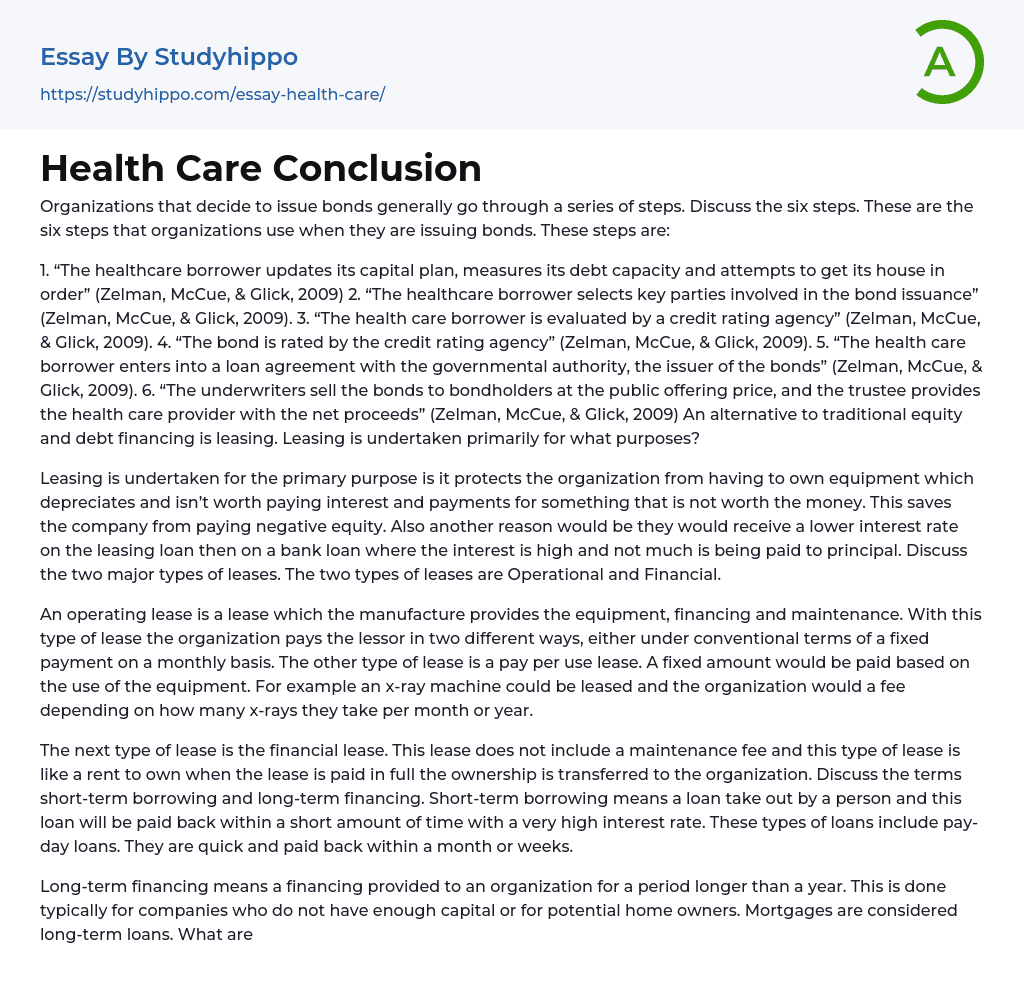Organizations that decide to issue bonds generally go through a series of steps. Discuss the six steps. These are the six steps that organizations use when they are issuing bonds. These steps are:
1. “The healthcare borrower updates its capital plan, measures its debt capacity and attempts to get its house in order” (Zelman, McCue, & Glick, 2009) 2. “The healthcare borrower selects key parties involved in the bond issuance” (Zelman, McCue, & Glick, 2009). 3. “The health care borrower is evaluated by a credit rating agency” (Zelman, McCue, & Glick, 2009). 4. “The bond is rated by the credit rating agency” (Zelman, McCue, & Glick, 2009). 5. “The health care borrower enters into a loan agreement with the governmental authority, the issuer of the bonds” (Zelman, McCue, & Glick, 2009). 6. “T
...he underwriters sell the bonds to bondholders at the public offering price, and the trustee provides the health care provider with the net proceeds” (Zelman, McCue, & Glick, 2009) An alternative to traditional equity and debt financing is leasing. Leasing is undertaken primarily for what purposes?
Leasing is undertaken for the primary purpose is it protects the organization from having to own equipment which depreciates and isn’t worth paying interest and payments for something that is not worth the money. This saves the company from paying negative equity. Also another reason would be they would receive a lower interest rate on the leasing loan then on a bank loan where the interest is high and not much is being paid to principal. Discuss the two major types of leases. The two types of leases are Operational and Financial.
View entire sample
justify">An operating lease is a lease which the manufacture provides the equipment, financing and maintenance. With this type of lease the organization pays the lessor in two different ways, either under conventional terms of a fixed payment on a monthly basis. The other type of lease is a pay per use lease. A fixed amount would be paid based on the use of the equipment. For example an x-ray machine could be leased and the organization would a fee depending on how many x-rays they take per month or year.
The next type of lease is the financial lease. This lease does not include a maintenance fee and this type of lease is like a rent to own when the lease is paid in full the ownership is transferred to the organization. Discuss the terms short-term borrowing and long-term financing. Short-term borrowing means a loan take out by a person and this loan will be paid back within a short amount of time with a very high interest rate. These types of loans include pay-day loans. They are quick and paid back within a month or weeks.
Long-term financing means a financing provided to an organization for a period longer than a year. This is done typically for companies who do not have enough capital or for potential home owners. Mortgages are considered long-term loans. What are the primary sources of equity financing for not-for-profit healthcare organizations? The primary sources of equity financing are from corporations, foundations, individuals and bequests. This money totals in the billions for each organization.
The capital budgeting process occurs in several stages, but generally includes what? This
includes all the steps included in the capital project analysis. It also includes what monies are going to be spent or saved on projects or programs. Discuss and list the three discounted cash flow methods. * Net present value- “Capital financing alternative is a useful way to find other ways of capital financing. The NPV equals discounted cash inflows less discounted cash outflows (Cleverley, Song, & Cleverley, 2011) . Profitability index – “Capital expenditures with financial benefits” this method is to determine how much money is going to be made or how much money is going to be saved (Cleverley, Song, & Cleverley, 2011).
* Equivalent annual cost – “Capital expenditures with nonfinancial benefits” this means finding out how much projects in which the organization is going to cost financially as well as make the company money. Although there is no money involved this is an analysis to determine the amount of costs (Cleverley, Song, & Cleverley, 2011).
- Hospital essays
- Physician essays
- Health Care Provider essays
- Universal Health Care essays
- Readmission essays
- Bank essays
- Banking essays
- Corporate Finance essays
- Credit Card essays
- Currency essays
- Debt essays
- Donation essays
- Enron Scandal essays
- Equity essays
- Financial Accounting essays
- Financial Crisis essays
- Financial News essays
- Financial Ratios essays
- Financial Services essays
- Forecasting essays
- Foreign Exchange Market essays
- Free Market essays
- Gold essays
- Investment essays
- Legacy essays
- Loan essays
- Market Segmentation essays
- Money essays
- Personal finance essays
- Purchasing essays
- Retirement essays
- Shareholder essays
- Stock Market essays
- Supply And Demand essays
- Venture Capital essays
- Addiction essays
- Anatomy and Physiology essays
- Biodegradation essays
- Cancer essays
- Dental Care essays
- Disability essays
- Disease essays
- Disorders essays
- Health Care essays
- Infectious Disease essays
- Inquiry essays
- Intelligence Quotient essays
- Lung Cancer essays
- Medicine essays
- Neurology essays




